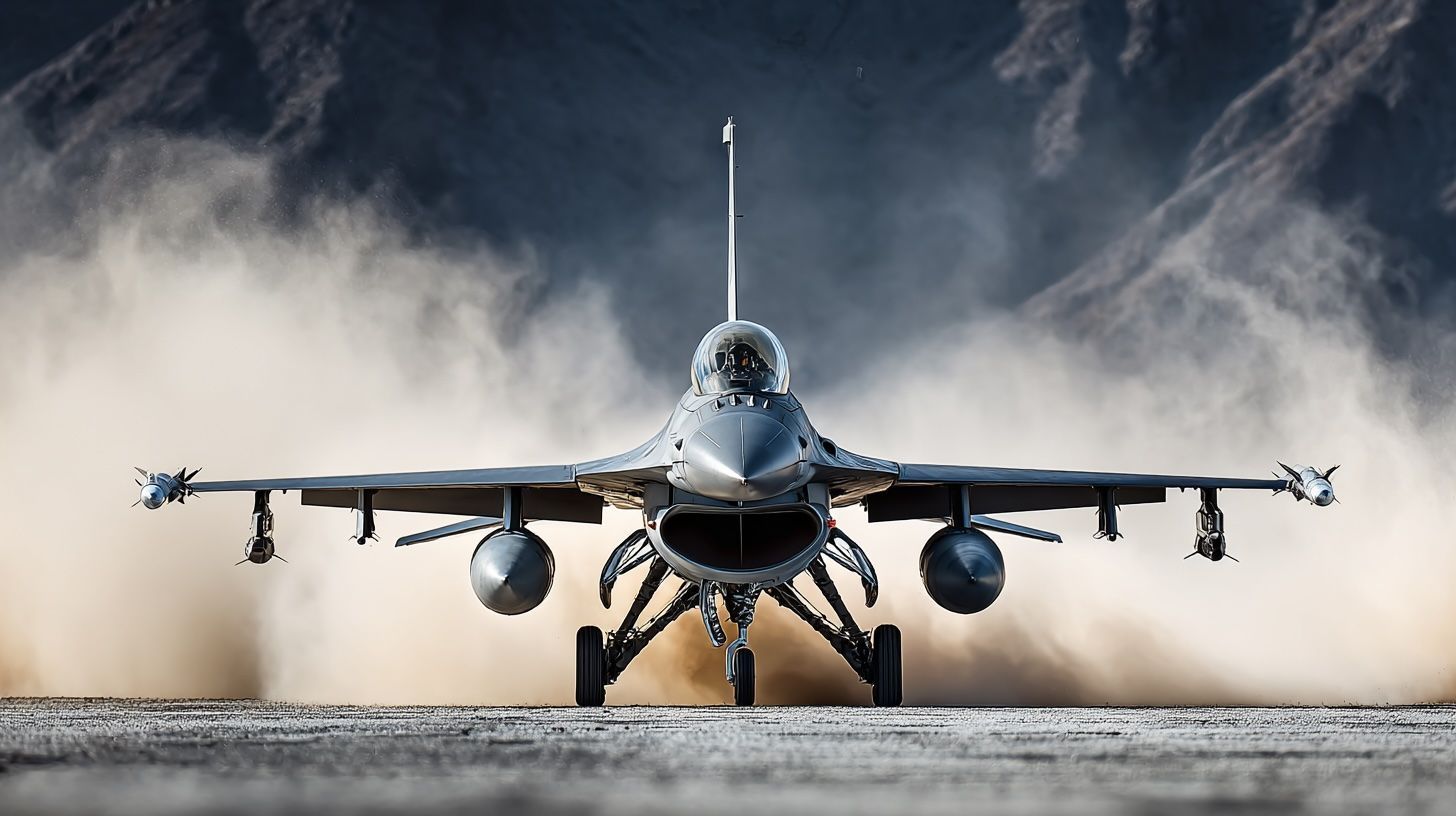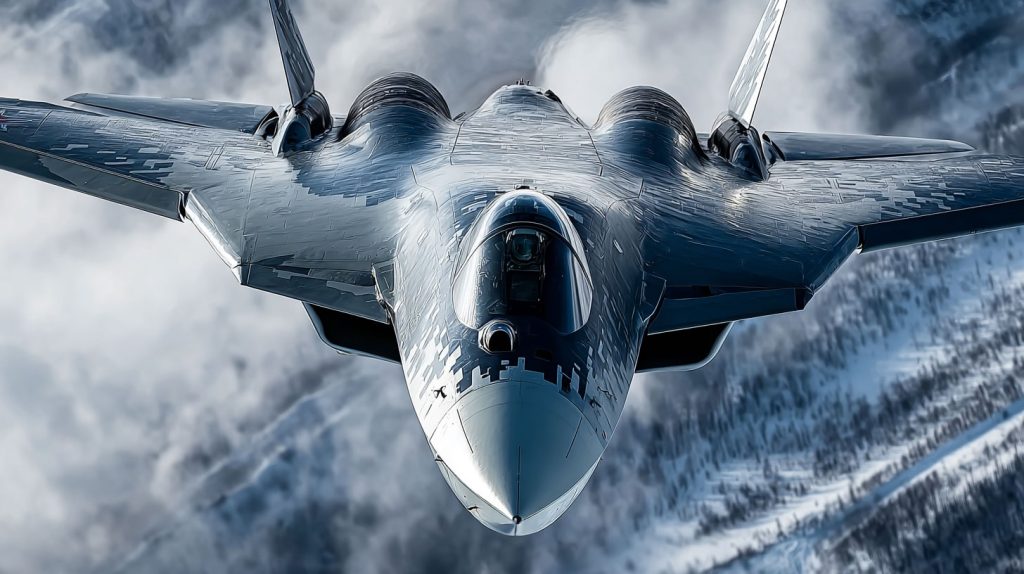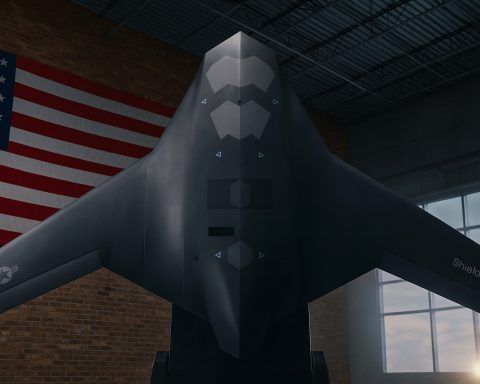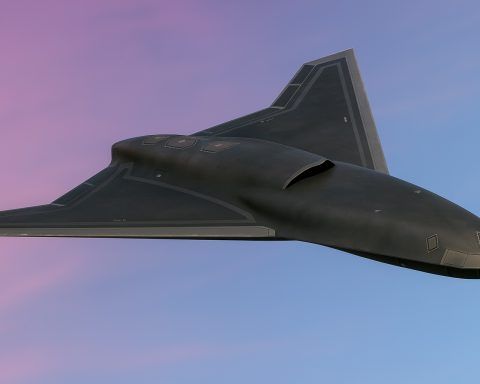- The F-16 began as General Dynamics’ YF-16 in the USAF’s Lightweight Fighter program, with the prototype’s maiden flight in 1974 and the first operational F-16A delivered in 1979.
- It introduced relaxed static stability and fly-by-wire controls, enabling exceptional agility and the ability to sustain 9 g turns.
- The cockpit features a frameless bubble canopy for 360-degree visibility and a 30-degree-reclined ejection seat to improve high-G tolerance.
- More than 4,600 F-16s have been built since 1976, and as of 2025 about 2,084 remain operational across 25 nations.
- An international NATO consortium—Belgium, Denmark, the Netherlands, and Norway—co-produced early F-16s, assembling 348 jets in Europe.
- Notable variants include the F-16E/F Block 60 Desert Falcon for the UAE with Conformal Fuel Tanks and AESA radar, and the F-16V Block 70/72 “Viper” with the AN/APG-83 AESA radar.
- The F-16 carries a 20 mm M61A1 Vulcan cannon and up to 11 hardpoints, allowing external stores in excess of 7,700 kg (about 17,000 lb).
- It can exceed Mach 2 (Mach 2.05 at 40,000 ft) and, with drop tanks, has a ferry range over 4,200 km.
- Its combat debut came in 1981 with Israel’s Operation Opera, and in 1982 Bekaa Valley battles led to 44 air‑to‑air kills with zero losses.
- In the 2020s, Block 70/72 F-16Vs are priced around $70–$85 million per jet, with flight-hour operating costs near $26,000, underpinning the F-16’s reputation as a cost-effective, upgradeable platform.
Introduction & Development History
The F-16 Fighting Falcon is a single-engine multirole fighter jet that first emerged from the U.S. Air Force’s Lightweight Fighter (LWF) program in the 1970s. Conceived by a group of innovative engineers known as the “Fighter Mafia,” the F-16 was designed as an affordable, lightweight day fighter with superb agility [1] [2]. General Dynamics built the YF-16 prototype to compete against Northrop’s YF-17, with the YF-16’s maiden flight in 1974 demonstrating impressive performance [3]. The F-16 won the fly-off competition and entered production in the late 1970s as a high/low mix companion to the heavier F-15 Eagle [4] [5]. The first operational F-16A was delivered in 1979 [6]. Over time, this nimble air-to-air fighter evolved into a versatile all-weather multirole aircraft, capable of precision ground attack in addition to dogfighting [7]. In total, over 4,600 F-16s have been built since 1976 [8], making it the largest fighter program in the Western world. Today, though the U.S. Air Force no longer buys new F-16s, production continues under Lockheed Martin for global customers, with improved variants still rolling off a new assembly line in Greenville, South Carolina [9]. The F-16 has been procured by the air forces of 25 nations and remains the world’s most common military aircraft, with 2,084 F-16s operational as of 2025 [10]. Its enduring popularity 50+ years on speaks to a groundbreaking design that has continually been upgraded to meet modern needs.
Development Milestones: The F-16’s story began with lessons from Vietnam – the U.S. realized it needed a highly maneuverable, energy-efficient fighter for close-in air combat [11]. Visionaries like Col. John Boyd advocated for a small fighter with high thrust-to-weight and low drag, leading to the LWF program [12]. The F-16 prototyped advanced technologies: it was the first fighter to adopt a relaxed static stability aerodynamics with fly-by-wire controls, giving it superb agility but requiring computerized stabilization [13]. The production F-16A entered service in 1980, and a unique international consortium of NATO allies (Belgium, Denmark, Netherlands, Norway) co-produced the early F-16s, assembling 348 jets in Europe in partnership with the U.S. [14]. General Dynamics later sold its aircraft division to Lockheed, so since 1993 Lockheed Martin has handled F-16 production [15]. Over the decades, the F-16 has seen numerous upgrades and variants (outlined later), evolving from the baseline F-16A/B to improved F-16C/D models and specialized versions for different countries. Nicknamed the “Viper” by pilots, the F-16 gained a reputation as a superb dogfighter with advanced strike capabilities. It remains in frontline service and is slated to fly with many air forces well into the 2040s [16], even as newer fifth-generation jets come online.
Specifications and Design Features
Airframe & Aerodynamics: The F-16’s design was revolutionary for its time. It features a streamlined fuselage with a blended wing-body and leading-edge strakes for agility. Notably, the cockpit has a frameless bubble canopy providing the pilot with unobstructed 360° visibility [17]—a critical advantage in dogfights. The pilot’s ejection seat is reclined 30° (versus the usual ~13°) to increase tolerance to high g-forces [18]. The F-16 was also the first production fighter to be built inherently unstable (relaxed static stability) and rely on a fly-by-wire flight control systemfor stability [19]. This design approach, combined with its high thrust-to-weight ratio, makes the F-16 extremely agile and able to sustain 9 g turns (it can withstand up to 9 g with full internal fuel) [20], outmaneuvering many contemporary fighters. For pilot control, the F-16 introduced a unique side-mounted control stick (on the right console instead of center) – this allows more precise control during high-g maneuvers with minimal arm movement [21]. The aircraft’s airframe extensively uses aluminum alloys (and later some composites) to achieve a lightweight yet strong structure. With a mid-mounted cropped-delta wing and leading/trailing edge flaps, plus a single all-moving stabilator on each side, the F-16’s aerodynamics are optimized for high roll rates (up to ~324° per second roll rate) and energy retention in turns [22]. All these features combined give the F-16 its famous nimble “viper” performance.
Engine and Performance: The F-16 is powered by a single afterburning turbofan engine. Early models used the Pratt & Whitney F100-PW-200 engine, while later Block variants also offered the General Electric F110-GE-100 – both in the 23,000–29,000 lbf thrust class. A typical F-16C/D engine (e.g. F100-PW-229 or F110-GE-129 in later blocks) produces about 27,000 pounds of thrust in afterburner [23], giving the F-16 an impressive thrust-to-weight ratio of ~1:1 at combat weight. This propels the F-16 to a maximum speed of approximately Mach 2.0 at high altitude (about 1,500 mph or 2,414 km/h) [24]. At sea level its top speed is around Mach 1.2 (~1,480 km/h) [25]. The F-16’s combat radius on internal fuel is on the order of a few hundred miles (e.g. ~546 km on a hi-lo-hi strike mission with bombs) and it can fly over 500 miles (860 km) in an air-to-ground mission with reserves [26]. For longer ferry flights, it can carry drop tanks – with three external tanks its ferry range exceeds 4,200 km [27], allowing intercontinental deployments. The aircraft’s service ceiling is over 50,000 ft [28], and it can climb at roughly 50,000 ft/min. Notably, the F-16’s design prioritized acceleration and instantaneous turn rate in the transonic speed regime of Mach 0.6–1.6 (where most air combat occurs) [29], giving it excellent performance in dogfights. In fact, the USAF noted that the F-16’s maneuverability and combat radius exceed that of all potential threat fighters of its era [30], a testament to its superior energy-maneuverability design.
Avionics and Sensors: The F-16 was built with a modular avionics architecture, enabling continuous upgrades over its lifespan. Key avionics include a multi-mode radar in the nose – early F-16A/B models used the Westinghouse AN/APG-66 pulse-Doppler radar, while later F-16C/D models were fitted with the AN/APG-68 radar (improved range and modes). Modern upgraded F-16s (Block 70/72, a.k.a. F-16V Viper) now feature an Active Electronically Scanned Array (AESA) radar, the Northrop Grumman AN/APG-83 SABR, which offers much greater detection range, high-resolution mapping, and improved reliability [31] [32]. (The AESA radar replaces the mechanically-scanned set – for example, Taiwan’s new F-16Vs are noted to have “the latest AESA radar” that can see farther than the older models [33].) In addition to radar, the F-16 can carry targeting pods such as LANTIRN or Sniper XR for FLIR and laser designation, enabling precision strike in day/night, all-weather conditions. It also has an integrated enhanced global positioning/inertial navigation system (EGI) for precise navigation [34]. Other avionics include UHF/VHF radios, a data link, and a defensive suite with radar warning receiver and optional jamming/countermeasure pods [35]. Later variants added an Infra-Red Search and Track (IRST) sensor (in some upgrades) for passive targeting. The cockpit of the F-16C features modern hands-on-throttle-and-stick (HOTAS) controls and glass displays. Notably, all F-16s since 1981 were built with provisions for beyond-visual-range missiles and night attack, leading to the F-16C/D variants that included new cockpit displays and interfaces for advanced weapons [36]. The continual avionics upgrades have kept the F-16’s combat systems on par with newer fighters – for instance, the latest F-16V includes a new mission computer and cockpit with large color displays to manage the increased sensor data.
Armament and Hardpoints: Though relatively small, the F-16 is a true multirole fighter-bomber with an impressive weapons loadout. It is armed with an internal 20 mm M61A1 Vulcan six-barrel rotary cannon in the left wing root (ammo capacity ~500 rounds) for close-range engagements [37]. For external ordnance, the F-16 has 11 hardpoints(stations) for carrying weapons and fuel tanks [38]. This includes two wingtip rails (usually for air-to-air missiles), six under-wing pylons (three under each wing), and three under-fuselage stations (centerline and two cheek stations under the air intake) [39]. The aircraft can carry up to 17,000+ pounds (~7,700 kg) of external stores, though a typical combat load is much less to preserve performance. In practice, a common payload might be two 2,000 lb bombs, two AIM-9 Sidewinder missiles, two AIM-120 AMRAAM missiles, plus two external fuel tanks [40]. The F-16’s hardpoints are very versatile – it can deploy air-to-air missiles (AIM-9, AIM-120, etc.), air-to-ground munitions (from unguided iron bombs and rockets to laser-guided bombs, JDAM GPS-guided bombs, anti-ship missiles, AGM-65 Maverick missiles, HARM anti-radar missiles), and even tactical nuclear bombs. In the air-to-air role, an F-16 typically carries up to six missiles (for example, 4 x AIM-120 medium-range and 2 x AIM-9 short-range). For ground attack, it can deliver precision-guided weapons with “superior accuracy”, using its avionics to accurately strike targets even in poor weather or at night [41]. Despite being smaller than twin-engine jets like the F-15, the F-16’s payload of over 6 tons across 9–11 stations means it can hit multiple targets in one sortie or perform self-escort strike missions (carrying both bombs and air-to-air missiles). This flexibility is a major strength of the F-16 as a multirole platform. In sum, the F-16 offers a low-cost, high-performance weapons system for allied nations, combining a high thrust engine, advanced sensors, and a wide array of munitions to tackle both air and surface threats [42] [43].
Top Speed and Performance Data
One of the F-16’s notable attributes is its excellent all-around performance for a single-engine fighter. Top Speed: The F-16 can exceed Mach 2 at altitude – specifically about Mach 2.05 (≈1,353 mph or 2,178 km/h) at 40,000 ft in a clean configuration [44]. This makes it supersonic across a wide range of altitudes (up to Mach 1.2 at sea level) [45]. While it’s not the absolute fastest jet (interceptors like the F-4 or MiG-31 are faster in straight-line speed), the F-16’s Mach 2 class speed is plenty for intercepting targets and gives it a significant kinetic energy advantage in combat. Acceleration is a strong suit – thanks to its high thrust and low weight, the F-16 accelerates rapidly, which is useful both in dogfights and for quick reaction intercepts.
Climb and Ceiling: The F-16’s powerful engine and aerodynamics yield a rate of climb around 50,000 ft per minute, enabling it to reach high altitudes quickly. Its service ceiling is above 50,000 feet (≈15 km) [46], which allows it to operate where thinner air can improve speed and fuel efficiency (or to launch weapons from a high altitude for greater range). In practice, F-16s often cruise or patrol in the 20,000–40,000 ft regime and can zoom to higher altitude when needed. The high-altitude performance also means the F-16 can engage high-flying threats or launch standoff weapons from altitude.
Range: In terms of range, the F-16 was designed to be smaller (and thus shorter-ranged) than larger twin-engine jets, but it still has respectable reach with external fuel. On pure internal fuel, an F-16C’s combat radius is on the order of 300–400 miles depending on mission profile (for example ~339 mi on a hi-lo-hi strike with bombs) [47]. When configured for ferry (maximum range), the F-16 can fly approximately 2,270 nmi (4,217 km) with drop tanks [48]. The USAF fact sheet cites a ferry range of “more than 2,002 miles” (~1,740 nmi, or 3,220 km) [49], but with three tanks the 4,200 km figure is commonly noted. Essentially, an F-16 with inflight refueling or external tanks can deploy across oceans. With two external tanks, a typical range might be ~1,500 nmi. It’s worth noting the combat radius (with weapons and fuel for return) is much smaller than the ferry range; for example, an F-16 in strike configuration can fly 500+ miles (860 km) to a target, deliver ordnance, and return to base [50] – a capability that exceeded most adversary fighters of its generation. The F-16’s range has been improved in some variants by the use of Conformal Fuel Tanks (CFTs) – for instance, the F-16E/F variants for the UAE carry extra fuel on the fuselage sides without occupying weapon stations.
Maneuverability: The F-16 is famed for its agility. It was one of the first fighters capable of sustaining 9 g turns, which far exceeds the tolerance of most pilots (the limit was set to 9g, and the jet can technically go a bit beyond that in emergencies) [51]. This agility comes from design features like the fly-by-wire control and relaxed stability (allowing it to be slightly unstable for greater responsiveness), a high thrust engine, and a moderate wing loading. In a dogfight, an F-16 can out-turn older 3rd-generation jets and is comparable to other top 4th-gen fighters (it famously had a very small turn radius and fast roll rate). The aircraft’s roll rate of over 300°/sec gives the pilot the ability to rapidly change direction in the horizontal plane [52]. All these factors made the F-16 exceptionally lethal in close combat; one evaluation noted it could “outmaneuver any potential threat fighter” when it first entered service [53]. Even as newer fighters have emerged, the F-16’s nimble performance is still highly respected.
In summary, the F-16’s performance profile – a high top speed around Mach 2, swift climb, ample range with tanks, and extreme agility – was ground-breaking for a “light” fighter of its era. It provides a well-balanced combination of speed, range, and maneuverability that remains relevant. Modern fighters like the F-35 may outmatch it in sensors and stealth, but in raw kinematic terms the F-16 can still hold its own and even outperform heavier stealth jets in some aspects (e.g. higher speed and G capability than an F-35A). This is partly why the F-16 continues to get upgrades and remains in demand worldwide.
Pricing and Operational Costs
One major appeal of the F-16 has been its cost-effectiveness. The aircraft was intended to be lower cost than twin-engine fighters, and indeed it has proven to be relatively affordable for its capability. Over the decades, prices have varied with different blocks and equipment, but some representative figures are: the unit cost of an F-16A/B was about $14.6 million (in FY1998 dollars), and an F-16C/D around $18.8 million (FY98) [54]. (In the mid-1980s, the flyaway cost of an F-16A was roughly $15 million, making it a budget-friendly fighter.) Of course, with inflation and advanced upgrades, newer F-16 versions cost more. The latest F-16V Block 70/72 models being sold in the 2020s are approximately in the $60–70 million per jet range for the base aircraft. For example, Bahrain’s 2017 purchase of 19 new F-16V fighters was a ~$2.8 billion package; the unit price for the aircraft alone (excluding weapons, support, training) was about $70 million each [55]. Similarly, Slovakia’s order of 14 F-16 Block 70s was reportedly around $800 million for the aircraft, also suggesting around $57 million each (though additional costs push the total package higher) [56]. By contrast, full packages (including armaments, spares, training) can raise the “per aircraft” cost significantly – e.g. a proposed sale of 66 F-16Vs to Taiwan in 2019 was estimated at up to $8 billion total [57]. But in general, a brand-new F-16 in the 2020s can be quoted roughly $70–$85 million depending on configuration [58], which is still considerably cheaper than a new fifth-gen fighter (for instance, an F-35A costs ~$80+ million for just the jet).
In terms of operational cost, the F-16 is also cheaper to fly than larger twin-engine aircraft. It burns less fuel (one engine vs two) and has a mature, widely-supported supply chain. According to recent estimates, the cost to operate an F-16 for one flight hour is around $26,000 [59]. This includes fuel, maintenance, and support. For comparison, an F-35A’s cost per flight hour is about $40,000 [60], and older twin-engine jets like the F-15 can be in the $30k+ range. So the F-16’s operating cost is roughly two-thirds that of an F-35 – a significant savings for air forces on a budget. Some sources indicate a basic operating cost closer to $22k/hr for an F-16C, but with all factors considered (sustainment, spares) $25–30k/hr is a reasonable figure in the 2020s [61]. The aircraft was explicitly designed for lower maintenance and lifecycle costs: it used many off-the-shelf proven systems and was simpler/smaller than earlier fighters, which reduced man-hours per flight hour requirements [62].
Lifecycle and upgrade costs are also favorable – many countries have upgraded their F-16s (new radars, avionics, etc.) at a fraction of the cost of buying new aircraft. For example, a Mid-Life Upgrade (MLU) for older F-16A/Bs in Europe extended their service life and added modern weapons for a few million per jet, far cheaper than replacing them. Additionally, the single-engine design not only lowers fuel burn but also means engine overhauls (a major maintenance cost) are half the number of a twin-engine fleet for the same number of jets. All these factors give the F-16 one of the best “bang for the buck” ratios in combat aviation. It provided a “relatively low-cost, high-performance weapon system” to the U.S. and allies [63], and that remains true even today when comparing its operating economics to newer fighters.
Pilot Gear and Helmet Technology
Flying the F-16 is an intense experience, and over the years pilot gear has evolved to help the pilot better interface with the jet’s capabilities. A focal point of modern F-16 pilot gear is the Helmet-Mounted Display/Cueing System. The current standard is the Joint Helmet-Mounted Cueing System (JHMCS), which greatly enhances situational awareness and weapon cueing. With the JHMCS helmet, F-16 pilots can simply look at a target to lock an infrared-guided missile onto it – the helmet tracks the pilot’s head movement and projects targeting data onto the visor, so wherever the pilot looks, sensors and weapons can follow [64] [65]. This means in a dogfight, an F-16 can fire high off-boresight missiles (like the AIM-9X Sidewinder) at enemies even outside the nose direction, just by the pilot turning their head to cue the missile [66] [67]. The JHMCS also displays critical info like radar tracks, targeting pods imagery, or datalink cues right on the visor, so the pilot doesn’t have to look down at HUD as much [68]. Effectively, the helmet becomes a personal HUD, showing altitude, threats, weapons status, etc., wherever the pilot looks.
The latest iteration, JHMCS II, was tested with the new F-16V Block 70/72. This upgraded helmet introduces an optical inertial tracking system for even more precise head-tracking, and it has a refined center-of-gravity to reduce neck strain on long missions [69]. Notably, JHMCS II comes with a color display on the visor, which allows more intuitive presentation of information (since humans can absorb more info with color cues) [70]. It’s designed to be lighter and better balanced (aligning with the spine) to mitigate fatigue [71]. These helmets are being integrated as the baseline for new F-16Vs [72] [73]. Even the earlier JHMCS (used since the 2000s) gave F-16 pilots a huge edge; now JHMCS II further enhances that advantage.
Apart from helmet displays, F-16 pilots wear typical modern fighter gear: a g-suit that automatically inflates to squeeze the legs and abdomen during high-g turns (helping withstand 9 g maneuvers), a pressure mask for high altitude breathing, and often Night Vision Goggles (NVGs) for night operations (though helmet displays can project IR imagery now, reducing the need for NVGs). The F-16’s cockpit was one of the first to have a high-visibility HUD (Head-Up Display), and while the HUD remains, much of its symbology can also be shown on the helmet visor in newer mods [74]. The F-16’s HOTAS controls mean the pilot can access weapons, radar, communications, and countermeasures without taking hands off the throttle or stick, which is critical in combat.
It’s also worth noting how F-16 pilot gear has influenced even newer jets. For example, the F-35 now uses a helmet in lieu of a HUD – a concept proven in part by the success of helmet systems like JHMCS in F-16s. The JHMCS on F-16s offers a 20×40° field-of-view for symbology on the visor and includes a sunshade and laser visor protection, preparing pilots for any lighting conditions [75]. In high-threat combat, this helmet system is a true force multiplier, allowing split-second targeting and improved situational awareness [76]. In short, the F-16 pilot’s “helmet and visor” have become as important as the aircraft’s radar or weapons – they form an integrated weapon aiming and information system that keeps the pilot lethal and informed at all times.
Global Users and Production History
The F-16’s global footprint is enormous. It has served (or is still serving) in the air forces of over 25 countries on five continents [77]. Major operators outside the U.S. include Belgium, Netherlands, Norway, Denmark (original NATO partners), Turkey (which has one of the largest fleets), Israel (which has used F-16s extensively in combat), Egypt, South Korea, Japan (operates the F-2, a derivative), Pakistan, Poland, Greece, Taiwan, and many others. As of 2025, more than 2,000 F-16s remain in active service worldwide [78], making it the most common fighter model in service. In total, around 4,600 F-16s were built from the late 1970s through today [79], a production number rivaled by few jet designs (the MiG-21 being one of the few higher, though much older). This success is a result of effective design, continuous upgrades, and international collaborations.
Production History: The F-16 was originally produced by General Dynamics in the U.S., with the first units built in Fort Worth, Texas. To fulfill large orders for NATO, an unusual multinational co-production consortium was established in the late 1970s. The U.S., Belgium, Netherlands, Denmark, and Norway cooperated so that F-16 components were made in all five countries, and final assembly lines were set up in Belgium and the Netherlands for the European F-16s [80]. This produced the initial ~348 F-16s for those four NATO allies, with technology transfer and shared logistics as a benefit [81]. Later, other countries like Turkey and South Korea would also license-produce F-16s domestically. Turkey’s TAI assembled many of its F-16s (and is now seeking to build new Block 70s), while Korea’s KAI built the KF-16 (Block 52) in the 1990s. This widespread production capability is one reason the F-16 proliferated so widely.
In 1993, General Dynamics sold its aircraft manufacturing to Lockheed (which merged into Lockheed Martin in 1995) [82]. Lockheed Martin continued F-16 production and upgrades. By the mid-2000s, production had slowed as the U.S. stopped new purchases (the last new F-16 for the USAF was delivered around 2005). However, international demand kept the line alive. Notably, new orders in the late 2010s led Lockheed to open a fresh F-16 production line in Greenville, SC (transferring from Fort Worth which was focusing on the F-35). The F-16 Block 70/72 “Viper” is now being built for countries like Bahrain, Slovakia, Bulgaria, Taiwan, and others. Lockheed Martin anticipated hundreds of upgrades to F-16V and potentially up to 500 new-build F-16s to be sold over the next decade(as of 2020) [83], which could bring total production well past 5,000 units. This is a remarkable second life for the fighter.
Global Impact: The ubiquity of the F-16 means it has been a backbone of many allied air forces. For example, Israelwas one of the first export customers (received F-16s in 1980) and they have since customized their fleet (e.g. F-16I Sufa) – Israeli F-16s have seen extensive combat (Lebanon, Syria, Iraq, Gaza). Turkey operates well over 200 F-16s and they form the core of its air force. Pakistan has used F-16s in multiple conflicts and internal security operations. European operators used their F-16s in coalition operations in the Balkans and Middle East. Egypt and United Arab Emirateshave F-16s as mainstays of their fighter fleets. The plane’s reliability and versatility made it a sort of “world standard” for 4th-generation fighters. It’s often the jet used in multinational exercises because so many nations have it.
Production Continues: A key point in F-16 production history is that it didn’t die out with the end of the Cold War. Instead, the jet was continually refreshed – e.g., the F-16 Block 50/52 in the 1990s added new radar and weapons; the Block 60 for UAE (delivered mid-2000s) introduced AESA radar and conformal tanks; and now Block 70/72 adds state-of-the-art avionics. This has kept production going. The F-16 line paused in the mid-2010s but reopened in 2018/2019 due to new orders. The fact that dozens of air forces plan to operate F-16s into the 2030s and beyond means a continued pipeline for upgrades and even new airframes. Even the U.S. is upgrading National Guard F-16s with new AESA radars to keep them credible as the F-35 slowly replaces them [84]. Lockheed Martin has marketed a variant called F-21(essentially a customized F-16 Block 70) for India’s huge fighter requirement, showing that the design is still competing for new markets. All told, the F-16’s global user community ensures that the “Fighting Falcon” will remain a common sight in skies around the world for many years. As of 2025, it is the most numerous military fixed-wing aircraft in service worldwide [85] – a testament to its successful design and global appeal.
Combat Record and Deployment History
Few aircraft can claim the extensive combat record of the F-16 Fighting Falcon. It has participated in numerous conflictssince the 1980s under various flags, often proving decisive in those engagements. The F-16’s combat debut came in the early 1980s with the Israeli Air Force. In 1981, Israeli F-16s conducted the famous Operation Opera raid, bombing the Osirak nuclear reactor in Iraq. The next year, during the 1982 Lebanon War, Israeli F-16s engaged in massive air battles over the Bekaa Valley – achieving an astonishing 44 air-to-air kills against Syrian aircraft with zero losses in air combat [86]. These included many MiG-21s and MiG-23s shot down, showcasing the F-16’s superior dogfighting ability when paired with well-trained pilots and the then-new AIM-9L all-aspect Sidewinder. This established the F-16’s reputation as a formidable fighter in combat.
The United States Air Force first sent the F-16 to war during Operation Desert Storm in 1991 (the Gulf War). F-16s were the workhorses of the coalition air forces in Iraq – flying more sorties than any other aircraft type in that war [87]. USAF F-16s delivered precision-guided bombs on Iraqi strategic targets, performed “Scud-hunting” missions, and provided close air support. The F-16’s versatility was on full display: they attacked airfields, enemy air defenses, vehicle convoys, and even escorted rescue helicopters during the conflict [88]. Although the F-16 at that time lacked an internal FLIR for night attack (some were modified with LANTIRN pods during the war), they still proved effective in both day and night strikes. Notably, one F-16 was lost to a SAM over Baghdad, but overall the type had a high survival rate, especially given the large number of missions flown.
Throughout the 1990s, F-16s continued to see action. During Operation Allied Force (NATO’s air war over Kosovo/Serbia in 1999), U.S. F-16s flew SEAD (Suppression of Enemy Air Defenses) missions with HARM missiles, conducted offensive and defensive counter-air patrols, and carried out bombing strikes. F-16CJ variants equipped with HARM played a key role in neutralizing Serbian SAM sites. The USAF reported that F-16s in Allied Force performed outstandingly, destroying multiple enemy radar sites, vehicles, tanks, and even shooting down at least one MiG-29 during the conflict [89]. In one incident, an F-16AM (Dutch) shot down a Serb MiG-29 with an AMRAAM. During the 1990s no-fly zones over Iraq (Operations Northern Watch and Southern Watch), F-16s patrolled and occasionally engaged Iraqi air defense sites and aircraft.
Post-9/11, the F-16 was heavily involved in the War on Terror. In Operation Enduring Freedom (Afghanistan 2001+) and Operation Iraqi Freedom (Iraq 2003+), F-16s flew thousands of sorties [90]. They delivered precision strikes against Taliban and Al-Qaeda positions in Afghanistan, often using JDAM GPS-guided bombs and LITENING targeting pods to hit insurgent hideouts in rugged terrain. In Iraq, F-16s struck Republican Guard units, guided in special forces by acting as forward air controllers, and later conducted routine patrols against insurgent targets. The multirole nature of the F-16 was crucial – on one sortie a pilot might drop a laser-guided bomb on a ground target, and on the next he might be providing top cover to deter enemy fighters (though Iraq’s air force didn’t fly in 2003, the F-16s were prepared for air threats).
Other nations have also bloodied the F-16 in combat. Pakistan used its F-16s in border skirmishes and notably in the 2019 India–Pakistan standoff, where an F-16 allegedly shot down an Indian MiG-21 (though this is disputed, the wreckage of an AMRAAM suggested an F-16 engagement). Turkey employed F-16s in the 2015 shootdown of a Russian Su-24 that briefly entered Turkish airspace near Syria. Turkish F-16s have also been used extensively against insurgent targets and in the Syrian conflict for air strikes. United Arab Emirates flew F-16E/F Desert Falcons in the campaign against ISIS in Syria and Iraq, striking terrorist targets with precision munitions.
In the air-to-air arena, beyond the Israeli successes, there have been a few engagements: e.g., USAF F-16s shot down a Serbian MiG-29 in 1999 (as noted), and also in 1994, USAF F-16s enforcing the no-fly zone in Bosnia downed 4 Bosnian Serb jets (J-21 Jastrebs) in a brief dogfight. Pakistan’s F-16s have downed Soviet/Afghan aircraft in the 1980s (during the Soviet-Afghan war, Pakistani F-16s shot down several Afghan Su-22s and An-26s that violated their airspace). These instances have reinforced the F-16’s capability as a fighter.
However, F-16s are not invincible – there have been combat losses. Aside from surface-to-air missiles (which have shot down a handful of F-16s over the years, including in Bosnia and Iraq), at least one F-16 fell in air combat: a Pakistani F-16 was shot down by another (in a friendly fire incident in 1987). An Israeli F-16I was downed by a Syrian SAM in 2018 during strikes on Iran-backed targets (the crew ejected) [91]. These losses are relatively few considering the vast number of combat sorties flown by F-16s globally.
Overall, the F-16’s combat record is one of overwhelming success. It has performed air-to-air, air-to-ground, reconnaissance, Wild Weasel (defense suppression), and even humanitarian missions (the F-16’s speed was used to deliver medical supplies in some cases). It’s a true multirole platform that has “proven itself in air-to-air combat and air-to-surface attack”, as the USAF summarizes [92]. Its presence in so many conflicts, often at the forefront, underscores its reliability and capability. As of the mid-2020s, F-16s remain on combat duty – for instance, Israeli F-16s saw action in strikes against terrorist organizations, and various F-16 operators stand ready on NATO’s eastern flank amid renewed tensions in Europe.
Comparison with Other Fighter Jets
How does the F-16 stack up against other prominent fighter aircraft? Below is a comparison of key specifications and features of the F-16 Fighting Falcon versus several other jets, ranging from modern fifth-generation stealth fighters to contemporaries and older legacy fighters. The table highlights speed, range, radar type, approximate cost, and weapons load for each:
| Fighter Jet | Top Speed | Ferry Range | Radar | Unit Cost | Weapons Load |
|---|---|---|---|---|---|
| F-16 Fighting Falcon | Mach ~2.0 (2,120 km/h) [93] | ~4,220 km (with drop tanks) [94] | AN/APG-68 PD; APG-83 AESA (new) [95] | ~$70M (Block 70, flyaway) [96] | 11 hardpoints, ~7,700 kg payload [97] [98] |
| F-35A Lightning II | Mach 1.6 (1,960 km/h) [99] | ~2,800 km (internal fuel) [100] | AN/APG-81 AESA (stealth optimized) | ~$80M (latest LRIP lot) [101] | 10 hardpoints (4 internal, 6 external), ~8,160 kg payload |
| Dassault Rafale | Mach 1.8 (1,912 km/h) [102] | ~3,700 km (with 3 tanks) [103] | Thales RBE2-AA AESA | ~$90–120M (varies, ~$125M France) [104] [105] | 14 hardpoints, ~9,500 kg payload (excellent payload) |
| Sukhoi Su-35 Flanker-E | Mach 2.25 (2,400+ km/h) [106] | ~3,520 km (1,900 nmi) [107] | NIIP Irbis-E PESA (very powerful) | ~$85M (est. export price) [108] | 12 hardpoints, ~8,000 kg payload (high agility with TVC) |
| Chengdu J-20 Mighty Dragon | Mach ~2.0 (est.) [109] | ~5,500 km (3,000 nmi) [110] | Type 1475 AESA(estimated) [111] | ~$100–110M (est.) [112] | 6 internal + 4 external, ~11,000 kg payload (stealth load ~2,000 kg internal) |
| Mikoyan MiG-29 Fulcrum | Mach 2.3 (2,450 km/h) [113] | ~2,100 km (with tank) [114] [115] | Phazotron N019 Slot Back(PD radar) [116] | ~$20M (1980s), not in production | 7 hardpoints, ~4,000–4,500 kg payload (short range) |
| F/A-18C Hornet(Legacy) | Mach 1.8 (1,915 km/h) [117] | ~3,300 km (with 3 tanks) [118] | AN/APG-65/73 (pulse-Doppler) | ~$30M (1990s), retired USN | 9 hardpoints, ~6,200 kg payload [119] (carrier-capable) |
| F-4E Phantom II | Mach 2.2+ (2,370 km/h) [120] | ~2,700 km (1,457 nmi) [121] | AN/APQ-120 (pulse radar, analog) | ~$2.4M (1960s new) [122] | 9 hardpoints, ~8,400 kg payload [123] (no internal gun on early models) |
Citations: F-16 speed and range [124] [125]; F-16 radar and payload [126] [127]. F-35 data [128], cost [129]. Rafale speed [130], range [131], cost [132] [133]. Su-35 stats [134] [135]. J-20 stats [136] [137]. MiG-29 speed/range [138] [139], radar [140]. F/A-18 speed/range [141] [142], payload [143]. F-4 speed/payload [144], cost [145].
Analysis: From the table, we see the F-16 holds its own in many categories. It’s one of the faster jets listed (Mach 2 class, while newer stealth fighters like the F-35 and Rafale top out below Mach 2). Its range is shorter than big twin-engine fighters like Su-35 or J-20, but acceptable with refueling. The F-16’s radar in latest form (APG-83 AESA) is state-of-the-art, though earlier F-16s had older radars; still, many 4th-gen jets have received AESA upgrades similarly (Rafale’s RBE2 AA, F-15’s APG-82, etc.). The F-16’s cost is clearly much lower than most current fighters – the F-35, Rafale, Typhoon, Su-35 all tend to be more expensive per unit (when including all equipment). Only the legacy MiG-29 and F-4 were cheaper, but those are from earlier eras and are not really in production now.
In terms of weapons load, the F-16’s ~7.7 ton capacity across 11 stations is very respectable for a single-engine jet – it’s more than the Gripen (~5 tons) but less than larger jets like Rafale or Su-35 (which can lug 8–9+ tons). Still, the F-16 can carry all the necessary ordnance for most missions (two 2000-lb bombs, missiles, tanks, etc., which is often the practical limit due to drag and mission requirements). Only in heavy strike missions would a Rafale or F-15 have a clear advantage by carrying more ordnance or fuel.
When comparing dogfight performance: the MiG-29 was often considered a peer of the F-16. The MiG-29 has similar speed and slightly better climb, but its older avionics and much shorter range hampered it. The F/A-18C had terrific nose-pointing agility at slow speeds, but was a bit slower and less powerful than the F-16. The F-4 Phantom is two generations older – it was a powerhouse in the 1960s with heavy armament and high speed, but by the 4th generation it was outclassed in maneuverability and had an old-style radar (and a huge radar signature). The F-16 effectively replaced the F-4 in many forces, offering better accuracy and close-combat prowess.
Against modern 4.5 gen fighters like Rafale or Su-35, the F-16 (especially upgraded) can still compete, but those newer designs have certain edges – Rafale has much more payload and range, plus some stealthier aspects and cutting-edge sensors (the Rafale’s Spectra EW suite, for instance). Su-35 is larger with powerful engines and radar, and thrust-vectoring for agility; however, the Su-35’s radar, while long-range, is PESA not AESA, and the jet’s huge size makes it a good target on radar – an AESA-equipped F-16 might actually detect a Su-35 at similar ranges. Of course, Su-35 can carry very long-range missiles (300 km range R-37M in theory) whereas F-16 typically carries AMRAAMs up to ~100 km.
F-35 vs F-16 is an interesting comparison: The F-35 is stealthy, with superb sensors (including the APG-81 AESA and DAS 360° IR system), but it’s slower and cannot dogfight at 9g like an F-16 can. In exercises, if an F-35 gets within visual range without having killed the F-16 first, the F-16 can give it a hard fight due to better kinematics. However, the F-35 would usually see the F-16 first on radar (the F-16 is not stealthy) and could fire first – that’s the generational difference. The F-16’s best hope in that scenario is using electronic warfare or an external jamming pod to even the odds.
In summary, the F-16 remains a well-balanced fighter: faster than the F-35 and Super Hornet, more agile than a MiG-29 in sustained turns, with avionics now upgraded to AESA standard and a proven combat record. It doesn’t have stealth or the payload of a larger twin-engine jet, but it is far cheaper and still lethal. This is why many air forces continue to field F-16s even as they introduce small numbers of 5th-gen jets – the F-16s can carry the bulk of missions, and the pricey stealth jets are used sparingly. The comparison also highlights the F-16’s adaptability; with the upcoming Block 70/72 F-16V, it closes much of the gap with newer 4.5 gen jets by incorporating advanced radar, modern weapons (AIM-9X, AIM-120D, JSOW, etc.), and improved survivability (JHMCS helmet, towed decoys, etc.). It truly earned the moniker of one of the “most successful warplanes in the world” [146] due to this blend of performance, upgradeability, and cost-effectiveness.
Upgrades, Variants, and Future Prospects
Over its long life, the F-16 has spawned a large number of variants and upgrades, each bringing new capabilities. The base model F-16A/B (single-seat and two-seat, respectively) was a day fighter delivered in the late 1970s/early 80s. Soon, improvements were integrated via Block updates. Notable F-16 blocks and variants:
- Block 15 (mid-1980s): Added two more underwing hardpoints (from 7 to 9 total initially) and upgraded radar, plus structural improvements. Many early F-16 operators upgraded to this standard.
- F-16C/D Block 25/30/32: Introduced in mid-1980s, the F-16C (single-seat) and F-16D (two-seat) had improved avionics, ability to fire beyond-visual-range AIM-7 and later AIM-120 missiles, and cockpit upgrades (color displays, HOTAS). Block 30/32 introduced engine choice: Block 30 used GE F110 engine, Block 32 used Pratt & Whitney F100 (this began the divergence of odd blocks = GE, even blocks = P&W for a time).
- Block 40/42 “Night Falcon”: Late 1980s, added LANTIRN pods for night/all-weather attack, improved INS/GPS, and strengthened landing gear for higher takeoff weight. This block integrated precision-guided munitions and had the ability to carry targeting pods for the first time, making the F-16 a true multirole striker at night.
- Block 50/52: Early 1990s, SEAD role capable with AGM-88 HARM (the F-16CJ), plus radar upgrades (AN/APG-68(V)5) and improved electronic warfare. This is the version many U.S. units used in the late 90s/2000s. Block 50 (GE engine) / 52 (PW engine) also have compatibility with newer weapons like JDAM and AIM-9X with JHMCS. These are among the most common in U.S. service today.
- Block 60: An advanced variant developed for the UAE, delivered mid-2000s. Designated F-16E/F, the Block 60 features Conformal Fuel Tanks (CFTs) along the upper fuselage to extend range, the AN/APG-80 AESA radar(first AESA on an F-16), an internal FLIR targeting system, and advanced avionics (including a broad HUD and new electronic warfare suite). The UAE’s F-16E/F, also called “Desert Falcon,” is one of the most advanced F-16 versions in operation in the 2010s. Its 32,500 lbf F110-GE-132 engine is also the most powerful engine fitted to an F-16 [147].
- F-16I “Sufa”: A specialized two-seat variant for Israel (delivered ~2004) based on Block 52 with CFTs. It has Israeli avionics and countermeasures (Israel often integrates its own electronic warfare systems and weapons, like Python IR missiles). The Sufa (Hebrew for “Storm”) can carry an enormous ordnance load and is optimized for long-range strike (e.g., it was rumored for potential Iran strike missions).
- F-16V Block 70/72 “Viper”: The latest production standard (first flight 2015, entering service in late 2010s). This is essentially a 4.5-generation rebuild of the F-16, featuring the AN/APG-83 AESA radar, a new Modular Mission Computer, large high-res cockpit displays, JHMCS II helmet, improved datalinks, an upgraded electronic warfare suite, and structural life extension (up to 12,000 flight hours). The F-16V also comes with an Automatic Ground Collision Avoidance System (Auto-GCAS) to enhance safety. This configuration is being sold to new customers (Bahrain, Slovakia, Bulgaria, Taiwan, etc.) and offered as an upgrade kit for existing F-16 fleets. Lockheed Martin expects hundreds of older F-16s will be retrofitted to the “V” standard [148], keeping them viable for decades. In effect, the Block 70 F-16V is the pinnacle of the Fighting Falcon’s evolution – often touted as “the most advanced 4th generation fighter” currently, given its new radar and avionics [149].
Aside from these, there have been special variants: the F-16A ADF (Air Defense Fighter) was a late-1980s U.S. variant optimized for interceptor duty (with radar tweaks for AIM-7 Sparrow use) for the Air National Guard. The F-16N was a version used by the U.S. Navy as an adversary trainer (stripped of cannon, used in the 1980s). There was also an F-16/79 experiment (using a J79 engine) and the famous F-16XL, a cranked-delta wing prototype in the 1980s that could carry double the ordnance – it lost the bid for an advanced tactical fighter to the F-15E Strike Eagle, but its design data informed later programs. Another notable derivative is Japan’s F-2 fighter, which is essentially a larger F-16 co-developed by Lockheed Martin and Mitsubishi – it has a bigger wing, longer range, and Japanese avionics. About 90 F-2s were built, and they serve with Japan’s Air Self Defense Force.
Upgrades Programs: Throughout its service, the F-16 has benefited from numerous block upgrades and mid-life upgrades (MLU). The European Participating Air Forces (EPAF: Belgium, Netherlands, Denmark, Norway) did an F-16 MLU in the 1990s to bring their Block 15s up to near Block 50 capability – including new radar modes, cockpit, and AIM-120 AMRAAM capability. The USAF has done Service Life Extension Program (SLEP) upgrades to extend structural life and add capabilities (for example, the USAF is equipping ~300 F-16s with AESA radars as part of a post-2017 upgrade plan to bridge the gap until enough F-35s are in service). As of 2022, the USAF even announced it would keep F-16s into the 2040s due to F-35 delays, with extensive upgrades planned [150]. These may include the new APG-83 radar, improved mission computers, and possibly new weapons integration (like the AGM-158 JASSM cruise missile on some F-16s).
Future Prospects: The F-16 is in a unique position. It’s an aging design, yet the demand for affordable, capable fighters means it still has a market. For countries that cannot purchase the ultra-expensive F-35 or who need to replace older MiGs and F-5s en masse, the F-16V offers a non-stealth high-performance solution. For instance, the U.S. has approved sales of F-16s to countries like the Philippines (which is considering 12–16 F-16s), and even in 2023, there were discussions about selling new F-16s to Vietnam [151] – which shows how geopolitical shifts make the F-16 a tool of diplomacy as well. Lockheed Martin has also pitched the F-16V as a complementary fighter to nations that will buy the F-35 but still need a cheaper workhorse. There is even talk of unmanned or “loyal wingman” usage of older F-16s – the USAF’s QF-16 program already converts retired F-16s into target drones, but these could conceivably be used as combat UAV wingmen in testing scenarios.
Eventually, the F-16 will be succeeded by newer platforms (the F-35 is intended to replace it in U.S. service, and European nations are moving to the F-35 or indigenous fighters). But given the sheer number in service, the F-16 likely has at least another 15–20 years of front-line use globally. The 2040 timeframe will likely see the last F-16s retired from major air forces, closing out an impressive 60+ year run since first flight. By then, unmanned combat aircraft or 6th-generation fighters may dominate. However, the F-16’s legacy is secure – it proved that a thoughtfully designed lightweight fighter could defeat heavier foes, it introduced technologies that became standard (fly-by-wire, relaxed stability, HUDs, etc.), and it became the benchmark for multirole fighters that all subsequent designs are measured against. As a final note on its future: even as active service winds down in some countries, F-16s may find second lives in contractor adversary fleets (for training) or in smaller air forces that buy used F-16s. For example, countries like Croatia and even Air USA (a private company) have bought ex-Israeli or ex-USAF F-16s to use. So the F-16 might grace the skies in various roles for decades to come, a true testament to its successful design.
In conclusion, the F-16 Fighting Falcon stands as one of the most iconic and important fighter aircraft in history. From its origin as a radical idea by the Fighter Mafia, through countless upgrades and combats, to its current status as a global guardian in many air forces, the F-16’s story is one of innovation, adaptability, and excellence. It’s a jet that earned the trust of pilots (“it’s a pilot’s airplane,” many say) and struck fear into adversaries. Even 40+ years on, the F-16 remains formidable – and with the latest tech infusion, it shows that sometimes an old falcon can be taught new tricks, continuing to dominate the skies well into the 21st century. [152] [153]
References
1. en.wikipedia.org, 2. en.wikipedia.org, 3. en.wikipedia.org, 4. en.wikipedia.org, 5. en.wikipedia.org, 6. www.af.mil, 7. en.wikipedia.org, 8. en.wikipedia.org, 9. www.c4isrnet.com, 10. en.wikipedia.org, 11. en.wikipedia.org, 12. en.wikipedia.org, 13. en.wikipedia.org, 14. www.af.mil, 15. en.wikipedia.org, 16. www.c4isrnet.com, 17. en.wikipedia.org, 18. en.wikipedia.org, 19. en.wikipedia.org, 20. www.af.mil, 21. www.af.mil, 22. en.wikipedia.org, 23. www.af.mil, 24. www.af.mil, 25. en.wikipedia.org, 26. www.af.mil, 27. en.wikipedia.org, 28. en.wikipedia.org, 29. en.wikipedia.org, 30. www.af.mil, 31. www.c4isrnet.com, 32. www.defensemirror.com, 33. www.defensemirror.com, 34. www.af.mil, 35. www.af.mil, 36. www.af.mil, 37. en.wikipedia.org, 38. en.wikipedia.org, 39. en.wikipedia.org, 40. www.af.mil, 41. www.af.mil, 42. www.af.mil, 43. www.af.mil, 44. en.wikipedia.org, 45. en.wikipedia.org, 46. www.af.mil, 47. en.wikipedia.org, 48. en.wikipedia.org, 49. www.af.mil, 50. www.af.mil, 51. www.af.mil, 52. en.wikipedia.org, 53. www.af.mil, 54. www.af.mil, 55. www.defensemirror.com, 56. www.f-16.net, 57. militarywatchmagazine.com, 58. bulgarianmilitary.com, 59. www.ndtv.com, 60. www.ndtv.com, 61. warwingsdaily.com, 62. www.af.mil, 63. www.af.mil, 64. united24media.com, 65. united24media.com, 66. united24media.com, 67. united24media.com, 68. united24media.com, 69. www.c4isrnet.com, 70. www.c4isrnet.com, 71. www.c4isrnet.com, 72. www.c4isrnet.com, 73. www.c4isrnet.com, 74. united24media.com, 75. united24media.com, 76. united24media.com, 77. en.wikipedia.org, 78. en.wikipedia.org, 79. en.wikipedia.org, 80. www.af.mil, 81. www.af.mil, 82. en.wikipedia.org, 83. www.c4isrnet.com, 84. www.c4isrnet.com, 85. en.wikipedia.org, 86. en.wikipedia.org, 87. www.af.mil, 88. www.af.mil, 89. www.af.mil, 90. www.af.mil, 91. en.wikipedia.org, 92. www.af.mil, 93. en.wikipedia.org, 94. en.wikipedia.org, 95. www.c4isrnet.com, 96. www.defensemirror.com, 97. en.wikipedia.org, 98. en.wikipedia.org, 99. www.aerotime.aero, 100. www.aerotime.aero, 101. www.ndtv.com, 102. en.wikipedia.org, 103. en.wikipedia.org, 104. www.aerotime.aero, 105. www.aerotime.aero, 106. www.aerotime.aero, 107. www.aerotime.aero, 108. www.aerotime.aero, 109. www.aerotime.aero, 110. www.aerotime.aero, 111. nationalinterest.org, 112. www.aerotime.aero, 113. en.wikipedia.org, 114. en.wikipedia.org, 115. en.wikipedia.org, 116. www.nationalmuseum.af.mil, 117. en.wikipedia.org, 118. en.wikipedia.org, 119. en.wikipedia.org, 120. en.wikipedia.org, 121. en.wikipedia.org, 122. mapsairmuseum.org, 123. en.wikipedia.org, 124. en.wikipedia.org, 125. en.wikipedia.org, 126. en.wikipedia.org, 127. www.c4isrnet.com, 128. www.aerotime.aero, 129. www.ndtv.com, 130. en.wikipedia.org, 131. en.wikipedia.org, 132. www.aerotime.aero, 133. www.aerotime.aero, 134. www.aerotime.aero, 135. www.aerotime.aero, 136. www.aerotime.aero, 137. www.aerotime.aero, 138. en.wikipedia.org, 139. en.wikipedia.org, 140. www.nationalmuseum.af.mil, 141. en.wikipedia.org, 142. en.wikipedia.org, 143. en.wikipedia.org, 144. en.wikipedia.org, 145. mapsairmuseum.org, 146. en.wikipedia.org, 147. en.wikipedia.org, 148. www.c4isrnet.com, 149. www.lockheedmartin.com, 150. en.wikipedia.org, 151. bulgarianmilitary.com, 152. en.wikipedia.org, 153. www.af.mil










